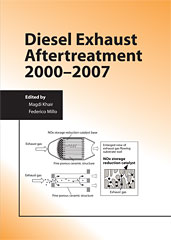Journal Article
Brief Investigation of SCR High Temperature N2O Production
2012-04-16
2012-01-1082
Nitrous Oxide (N₂O) is a greenhouse gas with a Global Warming Potential (GWP) of 298-310 (298-310 times more potent than carbon dioxide (CO₂)). As a result, any aftertreatment system that generates N₂O must be well understood to be used effectively. Under low temperature conditions, N₂O can be produced by Selective Catalytic Reduction (SCR) catalysts. The chemistry is reasonably well understood with N₂O formed by the thermal decomposition of ammonium nitrate. Ammonium nitrate and N₂O form in oxides of nitrogen (NOx) gas mixtures that are high in nitrogen dioxide (NO₂). This mechanism occurs at a relatively low temperature of about 200°C, and can be controlled by maintaining the nitric oxide (NO)/NO₂ ratio above 1. However, N₂O has also been observed at relatively high temperatures, in the region of 500°C.


